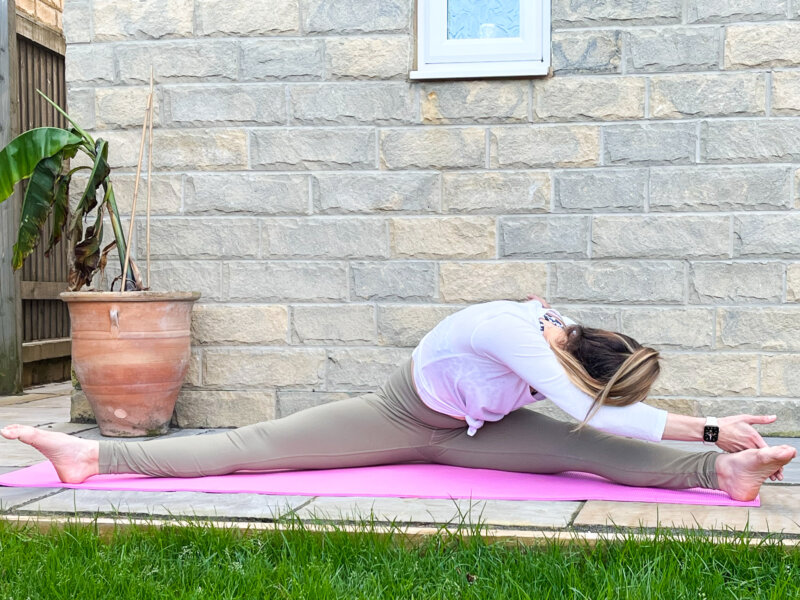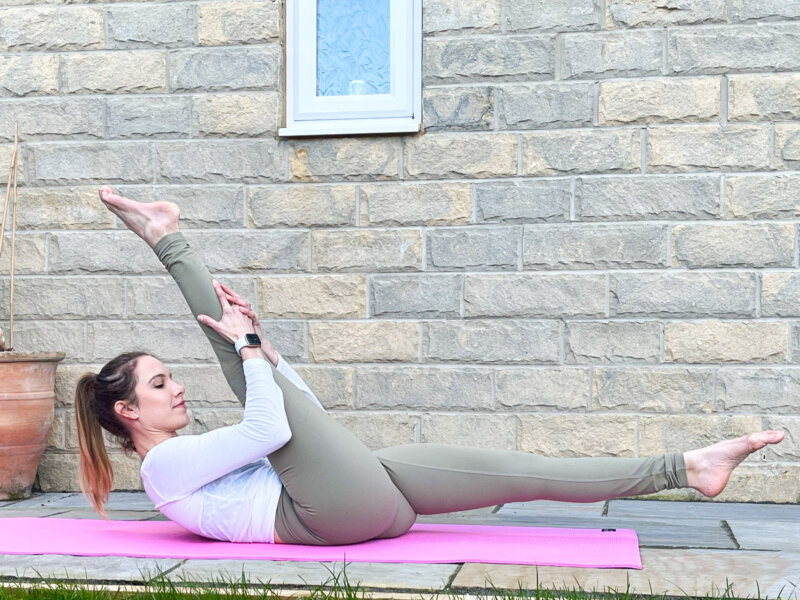Pilates For Flexibility & Mobility | 'Healthy Body' Series | Week 4
April 21, 2022'Hello' week 4 of my ‘Healthy Body’ Pilates series, where over the course of 6 weeks, I’ll be sharing just a few amazing ways in which Pilates can help to enhance your body!
It’s time to go back to basics and look at how Pilates can help one of the many aims and goals that draw people to establishing a Pilates practice in the first place: Improved flexibility & mobility.
Not only does Pilates improve overall body strength, stability, balance, coordination and control but it can also help to improve flexibility and mobility too!
How cool is that?
Pilates exercises are designed both strengthen and elongate the muscles to balance the body whilst opening through its various facial trains, improving flexibility.
Does that mean you have to be flexible or have a Cirque-Du-Soleil worthy splits to start practicing Pilates?
ABSOLUTELY NOT, my love. Not at all!
This is one of the biggest concerns I hear others share with me – that they’re not flexible or ‘bendy’ enough to establish a Pilates practice, so they don’t even start. Well that’s not true, beautiful.
Whether you can touch your toes or struggle to tie your shoelaces, Pilates can help you improve mobility within your body so that you can move with greater ease and fluidity.
Are you ready to feel more mobile, energised and discover a way of practicing loving movement that will serve you and your body in the best possible way?
Let’s go! Here are 5 Pilates exercises to help you work on improving your flexibility and mobility:
I’ve included how many repetitions I’d recommend, however be mindful of your body and tailor these exercises to suit you.
It’s also important to remember that everybody is unique and therefore the way these exercises are performed may need to be tailored to the individual. These step-by-step guidelines are there as a general ‘guide’ and if you require further information or help then please do not hesitate to get in touch.
HELPFUL REMINDERS:
- Think about creating balance within the body by keeping your pelvis level and your hips and shoulders even.
- Draw your shoulders down your back and away from your ears (shoulder stabilisation).
- Working the core also includes working the muscles in the back. Don’t forget core engagement with these exercises as the front and back of your body work together in strengthening that powerhouse of muscles!
*Remember to listen to your body and move in a loving way for you. By taking part in this exercise program, you are acknowledging that you are fit, well and healthy to do so and understand that you are performing the exercises at your own risk. Always consult your physician if you’re unsure or if you’re struggling with chronic back pain. And if you’d like to find out more information on how Pilates can help you and your body, then let’s have a chat!
**I have also filmed a YouTube Pilates flow showing you how you can sequence these exercises together which you can find either by clicking here, or by heading to the bottom of this article.

DEER POSE HIP LIFTS
8 Repetitions on each side
Helps improve hip mobility, core & abdominal strength, opens through the hip flexors & quads.
- Start in a seated position on the mat, keeping a 90 degree bend in both knees. Draw the right heel in towards the left hip, resting the shin parallel to the body on the mat. Square your body over the front leg. Rest the left leg out to the side of the body, maintaining a 90 degree bend in the knee.
- Lift up tall through the spine and elongate through the crown of the head.
- Draw the shoulders down your back and away from your ears. Keep your hands on your hips or extend your arms out in front of you, shoulder width.
- Inhale to prepare and as you exhale, begin to lift your hips away from the mat, lifting up taller through the spine.
- Squeeze your glutes at the top and then inhale to lower the hips back down to the mat with control.

GATE POSE ROCK BACKS
8 Repetitions on each side
Helps improve hip mobility, opens through the hip flexors & inner thighs.
- Start in a box position on the mat with the hands directing underneath the shoulders and knees underneath the hips.
- Elongate through your spine, finding and maintaining neutral spine, drawing your shoulders down your back.
- Extend your right leg out to the side, planting the foot down in line with the left knee, toes pointing towards the front. Square your hips so that they’re parallel to the mat.
- Inhale to prepare and as you exhale, hinge backwards drawing your hips down towards the mat.
- Inhale to hinge back up to the top.

SAW
8 Repetitions on each side
Helps improve core strength, strengthens the obliques, improves flexibility of the posterior chain, hip mobility, opens through the hamstrings & inner thighs.
- Start in a seated position on the mat, extending your legs out to the side in a straddle position. Keep a micro bend in your knees, with your kneecaps and toes pointing towards the ceiling.
- Lengthen up tall through the spine and elongate through the crown of your head.
- You may choose to side on a block or bolster to help lengthen through the spine.
- Inhale to prepare and on the exhale twist through your spine to face your right leg. Watch that your hips stay grounded on the mat and avoid lifting with the left hip.
- Exhale to hinge from the hips, folding over your right leg and squaring your chest to the mat. Focus on lengthening the spine.
- Reach your left arm to the outside of your right leg, slicing down the outside of your right leg like a saw. Keep your shoulders drawing down your back.
- Inhale to come back up to the top, lengthening through the spine and squaring your chest back to the front before repeating on the other side.

NECK PULL
12 Repetitions.
Helps improve core and abdominal strength, supports and mobilises the spine, opens up through the upper body & chest, improves posture and improves flexibility of the posterior chain & hamstrings.
- Start in a seated position on the mat with your legs extended out in front of you, lifting up tall through your spine, elongating through the crown of your head.
- Ground down evenly through both sitting bones.
- If you notice your tailbone tucking underneath you and are rounding through your spine, you may choose to sit on a block to help elevate the hips and find an anterior tilt to the pelvis.
- Bring the hands to the back of the head, opening the elbows out to the side, relaxing through the shoulders and drawing the shoulder blades down your back. If this feels uncomfortable, you may choose to bring the backs of your hands to your forehead.
- Inhale to lengthen through the spine, lifting tall.
- Exhale, drawing the chin in towards the chest, rolling down through the spine and lengthening over your legs.
- Elongate through your spine and then maintaining this length, lift back up to the top.
- Avoid ‘pulling’ on the neck, rather allowing the neck to lead the movement.

SCISSORS
10 Repetitions on each side
Helps to strengthen the core and abdominal muscles, improves pelvic stability as well as lengthens through the posterior chain and hamstrings.
- Start by lying supine on the mat (on your back), with your knees bent and feet on the mat.
- Draw your shoulders down your back, relaxing your arms down by the sides of your body.
- Engage your core and switch on you ‘imprinting’ (rib to hip connection), finding and maintaining neutral spine and pelvis.
- Lift the right leg up towards the ceiling, drawing it in towards your chest. You can choose to take a micro-bend in the knee here, or bend your knee to help facilitate this movement.
- Hold onto the back of your thigh, being mindful not to pull on the leg. Relax your shoulders and release tension from your upper body.
- Layer 1: Inhale to prepare and on the exhale, lift your upper body away from the mat, drawing it closer to your leg. Inhale to lower back down. Repeat for the desired number of repetitions and then repeat on the other side.
- Watch that your pelvis doesn’t lift away from the mat or tuck underneath you and lengthen through your spine throughout.
- Layer 2: Inhale to prepare and on the exhale switch legs, drawing the left leg in and elongating through the right. Inhale to hold and exhale switch. You may choose to keep your upper body on the mat, or lifted in a crunch.
Want to learn more about how Pilates can benefit your body?
Why not check these out:
- Online on demand Pilates classes (Practice Pilates with me anywhere, at any time – as long as you have access to internet!)
- My online Pilates Library (A library of a variety of 15 minute workouts so you can tailor your workout to suit your goal, ability and time-frame)
- New to Pilates? Try my 6 Week Beginners Pilates Course (Can be accessed at your own pace)
If you’re brand new to Pilates, having been meaning to try it for a while, establish a more regular Pilates practice, pick it back up after having a few years off, or simply want to learn more, then I’ve created an online course just for you! My 6 Week Beginner Pilates Course is completely online with 6 on demand classes and can be accessed at your own pace. You’ll not only learn the history of Pilates and how it can benefit your body and mind, but also refine your technique and learn how to Practice Pilates safely. How amazing does that sound? Check out my 6 Week Beginners Course here.
Over the course of 6 weeks, I want to share just a few ways in which Pilates can help support and enhance the physical wellbeing of your body so that you can feel more energised, vibrant and full of life – Yes, Pilates is an incredible form of strength training but it’s also a powerful method of mindfulness, meditation and relaxation.Catch up here:
- Week 1: Pilates For Back Pain
- Week 2: Pilates For Better Posture
- Week 3: Pilates For Digestion & Gut Health
1:1 Health Coaching
THESE ARE INDIVIDUAL SESSIONS THAT HELP YOU TRANSFORM YOUR LIFE AND HEALTH TO EMPOWER YOU TO BE THE CONFIDENT,...